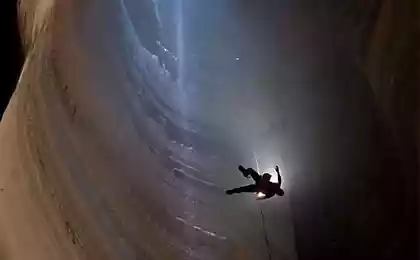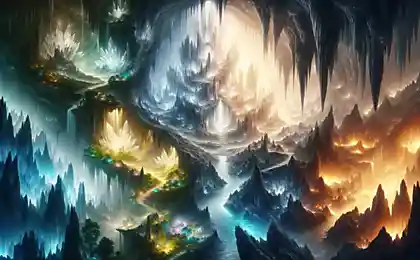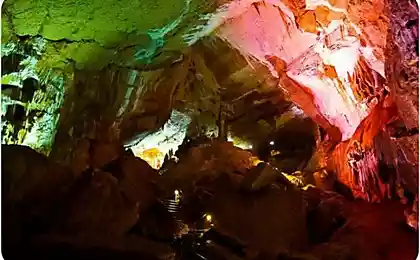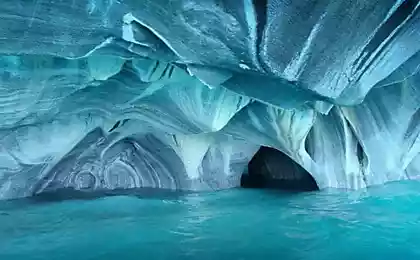401
9 Amazing Sea Caves in the World

Sea attractions
The most mysterious and awe-inspiring caves in the world formed along the coasts of oceans, seas and lakes. These geological landmarks, also known as coastal caves, have carved waves in rocky cliffs for millennia, finding the weakest and most easily crumbling places.
In addition to working for speleologists, underwater caves offer great opportunities for kayaking, swimming, diving, scuba diving and other water entertainment. Moreover, such formations can be found almost anywhere in the world from the European coastal regions to the Pacific coast of the United States.
We offer to get acquainted with nine of these wonders of the planet.
Fingal cave In Gaelic, the Fingal cave, which is located on the island of Staffa in Scotland, has the name “Uamh-Binn”, which means “cave of melody”. It is well known for its curved geological formations like the dome of the cathedral and the eerie sounds that visitors hear.
The Cave and the entire island of Staffa, like the Giant’s Road in Northern Ireland, consists entirely of hexagonal basalt columns, which form a natural bend of the ceiling. The easiest way to see the fearsome cave with your own eyes is to take a tourist cruise from the town of Mull. Vessels dock right near the cave, and hexagonal basalt columns can be perfectly used for walking along the shore and the entire cave.
Sea lion caves Sea lion caves in Oregon, USA, are known not only for being the most extensive sea caves in the world, but for a huge number of wild sea lions located on steep cliffs. This huge basalt formation is located a few kilometers from the American city of Florence. To get into the inner caves, visitors have to go down in an elevator deep underground, and then pass several more stairs and spans.
Alofaag Sea Fountains The small island state of Samoa boasts an interesting natural attraction - the Alofaaga fountains. During high tide, powerful waves burst through a series of holes created by lava flows.
Big blue hole. A large blue hole is located near the Lighthouse Atoll Reef, which is part of the Belize Barrier Reef. This is a huge underwater vertical cave with a diameter of 305 meters and a depth of 120 meters. Thanks to the beautiful and clear waters, as well as the variety of marine life living in its depths, the Great Blue Hole is a popular scuba diving destination.
Blue holes, which can be seen in abundance around the world, were formed due to erosion during ice ages, when the sea level of the Earth was much lower than it is now. While the Great Blue Hole is definitely the most impressive, it is not the deepest. The title of the deepest is Dean's Blue Hole in the Bahamas, which goes under water for 202 meters. In this video you can see how the world diving champion Guillaume Neri makes an immersion in this education.
Blue Grotto The Blue Grotto with its striking blue waters is one of the most famous sea caves in the world. It is located off the coast of the island of Capri, Italy. You can easily look at the cave with your own eyes, taking part in an organized sea tour. The entrance to the cave is so narrow that travelers are forced to lie down at the bottom of the boat as they progress. Therefore, unfavorable weather and high waters can prevent attempts to see the cave.
Painting Cave The painting cave on Santa Cruz Island off the coast of California, formed along a geological fault, is the second longest sea cave in the world. Its length is 374 meters, and the entrance is at a height of 40 meters.
The painted cave got its name thanks to multicolored stones, lichens and algae that decorated it from the inside. In spring, a cascading waterfall forms before the entrance to the cave. One of the easiest ways to experience this amazing attraction is to reach the island by boat and then explore the sea cave by kayak.
Ice Caves on the Apostle Islands In the US state of Wisconsin off the coast of the Apostle Islands you can see another unique natural attraction. In summer, kayaking travelers can explore each exquisite cave. In winter, when the lake freezes, these formations take on an amazing look. Visitors change kayaks for sturdy winter shoes and head to the caves to see frozen waterfalls and huge icicles.
But the island is known not only for its amazing caves, but also a kind of coastal ecosystem. This place is called home by many plants and animals, such as extensive populations of black bears and a variety of nesting birds. In the video you can see the caves in the summer.
Smoo Cave Smoo Cave is located near the Scottish village of Darness. This impressive geological landmark is carved into the limestone by the Alt Smu River, which runs above and flows into the cave through the hole. It has both sea and fresh water. The inner cavities were created by the Alt Smu River, but the easily accessible and wide entrance to the cave appeared due to erosion caused by sea water.
The cave is easy to access, with steps, passageways and recreational facilities enjoyed by the nearly 40,000 people who visit the site every year. In summer you can take part in excursions to the inner caves filled with water.
Pyula Cave Pool This natural source of fresh water, formed by chilled lava pipes, flows into the sea from the cave, and the place itself has become a favorite attraction for locals and visitors to the northern coast of the island of Upolu in Samoa. Tourists can camp nearby at Pyula Theological College, where they charge a small fee to attend.
Source: facepla.net























